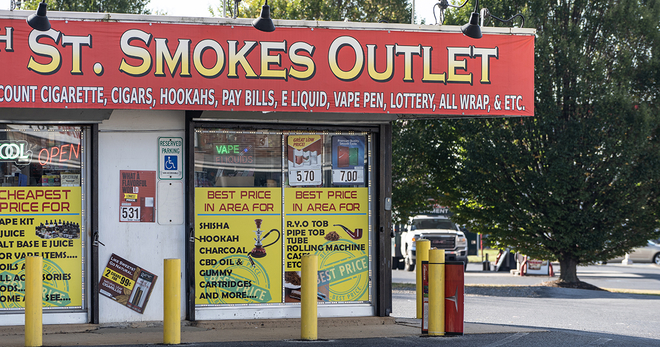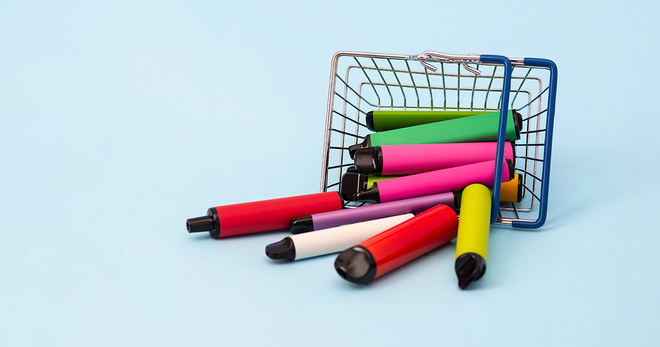How local and state governments are taking on in-store tobacco promotions
Tobacco companies spent over $8.6 billion on marketing in retail establishments, also called point-of-sale marketing, in 2014 (the most recent figures available). This article is part of a series highlighting ways that states and localities are countering the deep pockets of the tobacco industry with policies regulating where and how tobacco products are sold.
$8.6 billion
Tobacco companies spent over $8.6 billion on marketing in retail establishments in 2014
With most retailers and wholesalers receiving incentives from tobacco companies to promote tobacco products, state and local governments are acting to reduce the impact of tobacco product promotion.
Promotional incentives lead to more cigarette advertising and cheaper cigarette prices, which are linked to higher smoking rates. They can include promotional allowances — or payments made to retail store owners for stocking, shelving, displaying and merchandising brands — volume discounts, and free products retailers can later sell to consumers. Companies spent over $702 million of their $9.1 billion marketing budget for promotional allowances to wholesalers and retailers in 2014, the most recent year data are available.
There are few federal regulations regarding the promotion of tobacco products at the point of sale. The 2009 Tobacco Control Act prohibits distributing, marketing or selling any cigarette- or smokeless- branded, nontobacco items such as t-shirts and lighters. The law bans giveaways of any kind of nontobacco item, branded or not, with the purchase of a tobacco product or in exchange for a coupon or proof of purchase. It also bans vending machine sales outside of adult-only facilities. While all these restrictions apply to cigarettes and smokeless products, not all of them apply to other tobacco products such as cigars, e-cigarettes or hookah.
In the absence of stronger federal policies, state and local governments can help protect citizens from tobacco product promotion. While state and local lawmakers can’t restrict the content of advertising and promotion, they can regulate when, where and how it appears. Here are three ways states and localities are reducing the promotion of tobacco products in stores.
Limiting signs and advertisements
A 2015 study suggests that restricting tobacco product displays and ads at the point of sale in the U.S. would reduce smoking prevalence by 16 percent by the year 2065, and prevent 630,000 smoking-attributable deaths.
Some states and cities have enacted laws that limit the number, size and placement of all signs in general at retail outlets, which can lead to less tobacco advertising. In Philadelphia, only 20 percent of windows and transparent doors facing a street can be covered with signs. In California, any store that sells alcohol, except restaurants and bars, is prohibited from covering more than 33 percent of windows and clear doors with signs of any sort.
Controlling access to products
Policies that reduce access to tobacco products at the point of sale, such as raising the minimum age to purchase tobacco products to 21, can decrease tobacco use among youth and young adults and are very popular. In fact, as many as 75 percent of Americans, including most smokers, support a minimum age of 21 for purchasing tobacco. These laws don’t make tobacco marketing less appealing, but they do make it more difficult for young people to get their hands on tobacco products.
There are other ways to make tobacco products harder to get in retail establishments. The Tobacco Control Act bans cigarettes, cigarette tobacco and roll-your-own tobacco in self-service displays, except in adult-only facilities — but the law does not apply to other tobacco products, including cigars, hookah and e-cigarettes. Minnesota and New York prohibit selling any tobacco or tobacco-related devices in open displays accessible to the public without the help of a store employee, except in adult-only tobacco stores.
Banning giveaways and discounts
Tobacco companies still use promotions like sweepstakes and discounts to target certain audiences, including low-income populations. Retailers can redeem deals like buy one, get one free cigarette pack, or buy one pack of cigarettes and get a free pack of snus. Some coupons allow $1 or $2 off tobacco products. Tobacco companies also promote their products with sweepstakes for a chance to win cash prizes.
In the past, tobacco companies have offered items like blouses, coats, accessories and lighters in exchange for purchasing cigarettes. Now, federal law bans giveaways of any kind of nontobacco item with the purchase of a tobacco product. In New York City, retailers are prohibited from giving away or discounting nontobacco items, such as lighters, with the sale of tobacco products.
For more information on tobacco industry retail practices, including licensing and density, price and placement, read our fact sheet and policy resource.
More in tobacco industry marketing
Want support quitting? Join EX Program
By clicking JOIN, you agree to the Terms, Text Message Terms and Privacy Policy.
Msg&Data rates may apply; msgs are automated.


